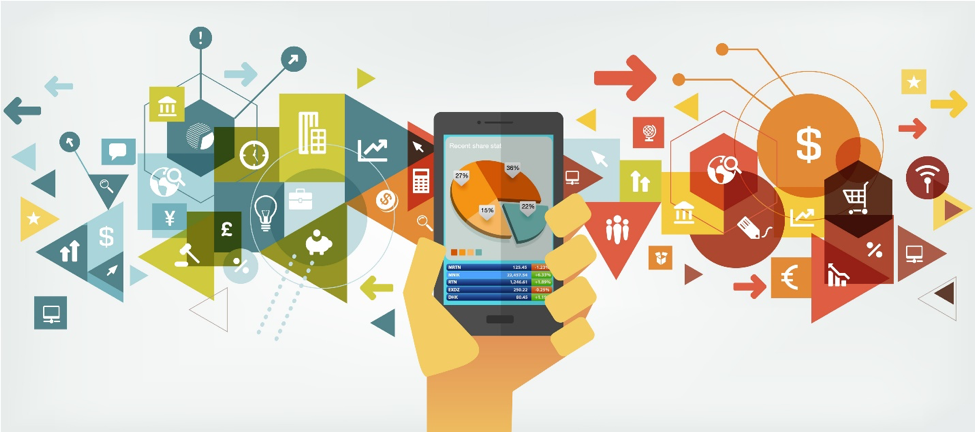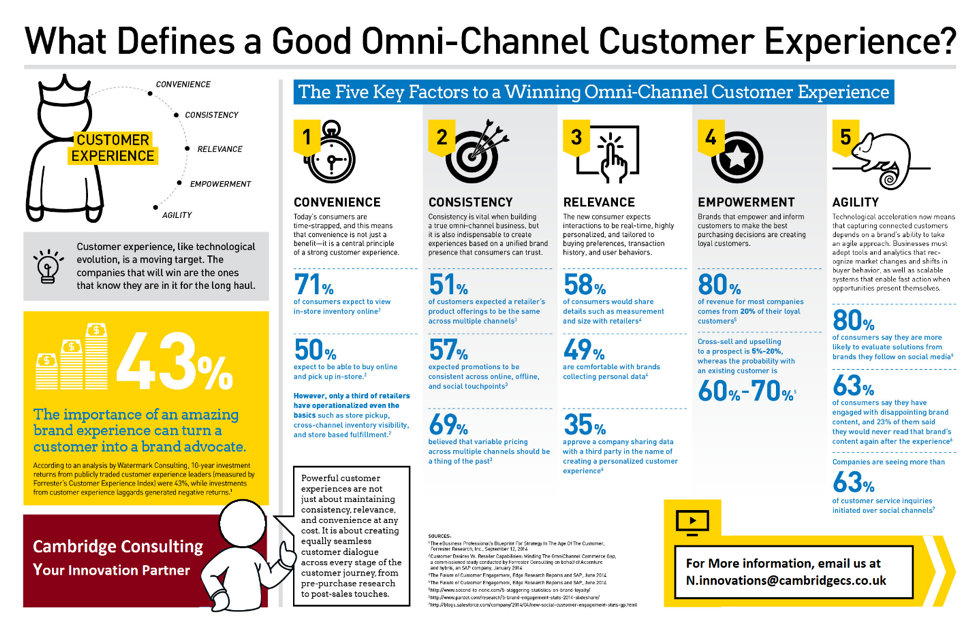
Defining omni-channel and the value of the omniscient customer experience.
In marketing and technology, you often know that something is still new when you can’t find one unanimous way to spell it. Ecommerce, eCommerce, e-commerce – remember those days? We now find Omni-channel, omni-channel and omni-channel across the web, each attached to prestigious brand and pundit thinking. Instead of arguing about the correct spelling, we just see it an indicator of something new and yet to be decided by the masses. By no means is the concept under-noted or fledgling. And, as with most things that are new, there are still developing ideas.
Omni comes from the word Omnis which can mean all or universal. This is in comparison to other categories out there, like “multichannel”, from the Latin word Multus, meaning multiple or many and from crosschannel, derived from the Latin word Crux, meaning to go across. The way that many are explaining omni-channel today is: ‘cross channel being done well’. Examples are often that the mobile app should match the responsive design of the website which should thematically reflect the look and feel inside the store. We’d argue that doing cross channel well with the user in mind, is not worthy (nor useful) enough to deserve a new category. Instead, we hold the belief that Omni channel is something new and notable, even revolutionary, not just a marginal evolution of existing thinking.
Great, so now that we’ve stated that omni-channel is being used merely as a buzzword for cross-channel with finesse – what is omni-channel? Omni channel is about true continuity of your experience. But what’s key is that it extends beyond a single brand’s universe. Being omniscient is perceiving and understanding all things. Not all things at Best Buy. Not all things at Target. Not all things at Gucci. Omni is perceiving all things. And the best way for a customer to perceive everything is to allow them to own their data and experience, then give them the ability to use it to guide creation and context of every future experience.
Think about it. Today our life is continuous, but our customer experience is anything but that. We learn and have memory of all the good and bad things in life. We strive to limit or eliminate the negative ones and increase the good. These patterns that we strive to replicate are our preferences. The ability to have a continuous experience across brands, across format and across devices that is completely bespoke – that is the promise of a new way of thinking and marketing that has been long unnoticed.
Myriad examples abound. I’m shopping for shoes. I go online. I see things I like and I save them in my Burtons account. I leave the website and go to Westfield to hit the shops. I walk in the door and I have no way to easily use my Burtons experience in an Office shoe store. I see some shoes at Office, then I end up going to Top Shop where I start fresh looking at what is in front of me in the moment. I can give 100 more examples of how my investment of time in research offline and online is a fragmented experience with some tools to make it more coordinated, but only within the bounds of a single brand. Which would be fine if I only shopped for shoes my entire life at Burtons. But the vast majority of the population likes to browse and compare to see what else is out there and once that happens, the ease and functionality of my omni-channel experience crumbles.
But wait you say, you can’t be suggesting that Burton’s help people buy shoes in Office. That would be counter to everything retailers try to do. The idea that retailers can stop people from shopping across brands or devices is mocked each time a bar code was scanned in a store to check competitors’ pricing.
When brands think customer experience they need to think omni. It’s not about your customers or their customers, it’s about all customers.
With the rise of NFC and personal device use in store, brands need to awake to the idea that the days of closed data and 75% off for loyalty points from only shopping at their brand are changing quickly. If a brand wants to start thinking omni-channel, then they need to be open and involved in making the customer’s experience continuous and universal. Have doubts? Look at the role of social media and customer relationship. Remember those brands who have refused to evolve and engage and have a dialogue? Many of them aren’t with us today.
As much as the social media revolution has meant the two-way exchange in dialogue and interaction, omni-channel is the realization of social business. If the first phase in the evolution of the customer relationship was messaging and media, the future is product research, selection and payment. With personal prefence data that can be used universally on devices, brand can either jump at the opportunities made real by omni-channel or wait until their brand is the only one not integrated and playing nicely to allow consumers to be continuous.
The brands who can best interpret omni-channel data and understand all customers are the winners. There will be a new dimension of customer decision. As a final decision is being made to purchase, price, relationship, service and continuity will all be considered.
If you’re thinking that matching the colors and content across devices is omni-channel, we would encourage you to reconsider. If you are ready to lead in the next phase of social business and get the most out of the promise that our new identity as customers is truly omniscient, then let’s connect. This way of thinking is the future promise on which we founded CloudTags.
There are a few key tennets that to acknowledge in order for this idea to be made reality:
- In exploring and discovering products in your brand domain that data should be transferable for me to collect and use universally.
- In exchange for this data, the customer will give you access to other data they have collected that will far outweigh the value of the limited data in your brand universe.
- All experiences offline and online should allow an individual to identify themselves and present a brand with the opportunity to access my preferences.
Omni-channel marketing has become key to marketing success as customers engage with companies in a variety of ways, including in a physical store, online via websites and mobile apps, through physical and virtual catalogs, and through social media. Consumers also utilize landlines and smartphones or tablets to search for products, access services, and make purchases. People also interact with brands and companies using apps on smartphones, tablets, desktop computers, and laptops. The challenge for organizations is to make all of these interactions and experiences as seamless, consistent, and effective as possible for customers.
Organizations must employ omni-channel marketing methods and strategies in order to meet customers where they are. Consumers expect more personalized communication with companies through the various channels and devices they use, and companies that do not keep up with the shift are losing ground to their competitors that do. Time Warner Cable senior VP of customer care John Bowden says organizations that are most successful with omni-channel marketing view it through the eyes of the customer, “orchestrating the customer experience across all channels so that it is seamless, integrated, and consistent. Omni-channel anticipates that customers may start in one channel and move to another as they progress to a resolution.”

One of the most significant challenges marketers and their organizations face when shifting to omni-channel strategies is knowing the difference between omni-marketing and multi-channel marketing. Because so many organizations struggle to make the jump from business-centric to customer-centric practices, they also struggle to put the customer at the forefront when they create integrated experiences for customers.
Breaking down silos and breaking free of traditional marketing campaigns also is difficult for some organizations when they first adopt omni-channel marketing practices. The shift to omni-channel also requires buy-in from the entire organization and a shift in company culture. As Leah Stigile, VP of global business for Toms Shoes points out, “Luckily, we have buy-in from across the organization for omni-channel,” and her company proactively works to ensure cohesion over time, especially with events such as their annual one day without shoes event to help people across all customer touchpoints band together around a unified message to drive awareness about people lacking necessities such as shoes.
Stacy Schwartz, digital marketing expert, consultant, and adjunct professor at Rutgers Business School, echoes the notion that an omni-channel approach must be a customer-centric marketing approach: “It acknowledges that mobile and social have enabled customers to not only quickly switch between channels, but actually use channels simultaneously. For example, checking out product reviews on their mobile phone while evaluating a product on a physical retail store shelf.”
The best omni-channel marketing strategies account for the fact that customers engage with companies in a variety of ways across platforms, and they ensure consistent experiences every time. Customers look for receiving personalized interactions and conversations with brands. Some of the best practices for omni-channel marketing include :
- Accounting for each platform and device customers use to interact with the company and then delivering an integrated experience to align messaging, goals, objectives, and design across each channel and device.
- Developing a unique omni-channel infrastructure with collaboration between several departments.
- Adopting new technologies: make sure your site is optimized for mobile and enable customers to stop directly from social media sites.
- Considering virtual reality experiences for customers.
- Testing customer experiences and measure everything.
- Segmenting your audience.
- Listening and responding on preferred channels and devices.
- Personalizing experiences and offering the most convenient interactions as possible.
- Omni-channel marketing is a must as customers and organizations have unprecedented access to digital technologies and channels. Our uber-connected world has created mounds of customer data for companies; if they use it correctly, they will be able to key into customer affinities and behavior to adopt omni-channel strategies and solutions to better manage the data, understand customers, and exceed customers’ expectations at each and every interaction.

